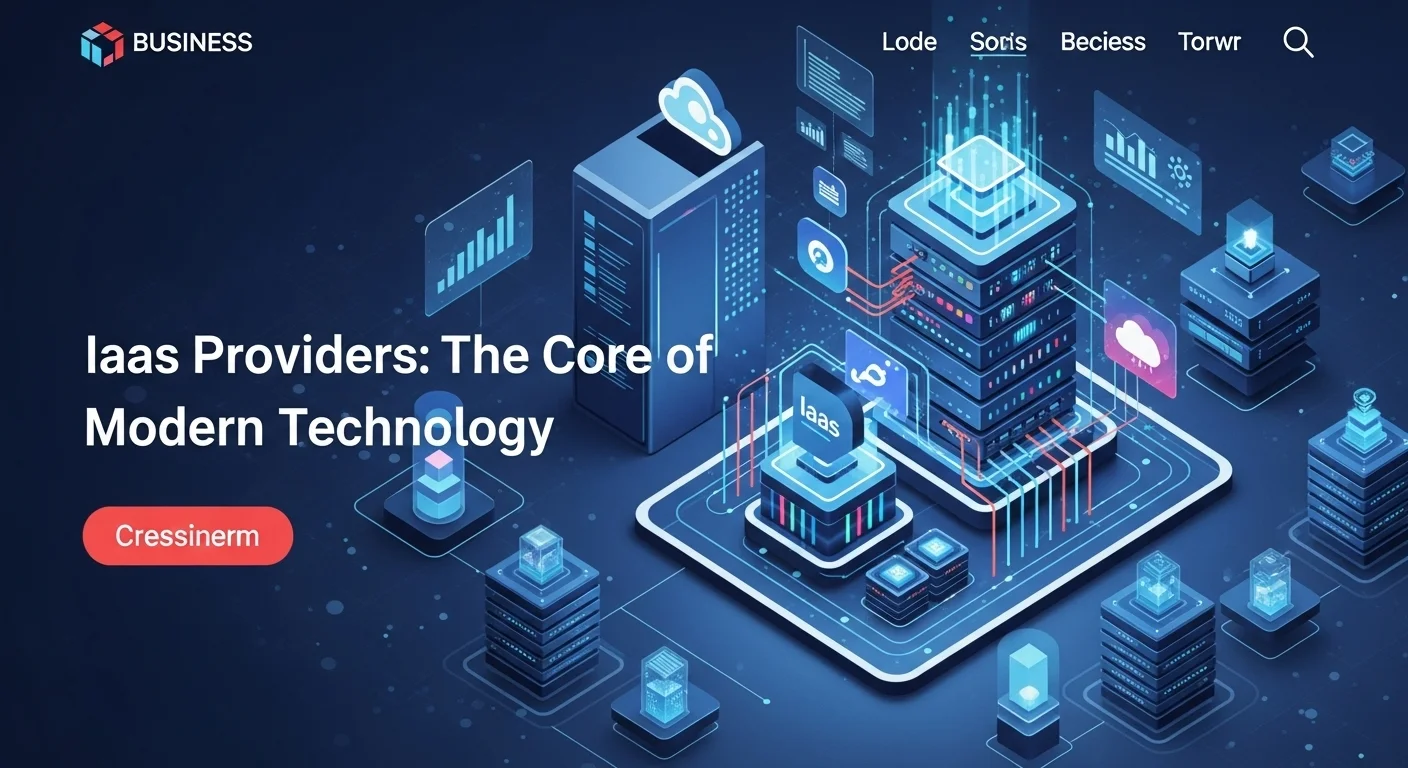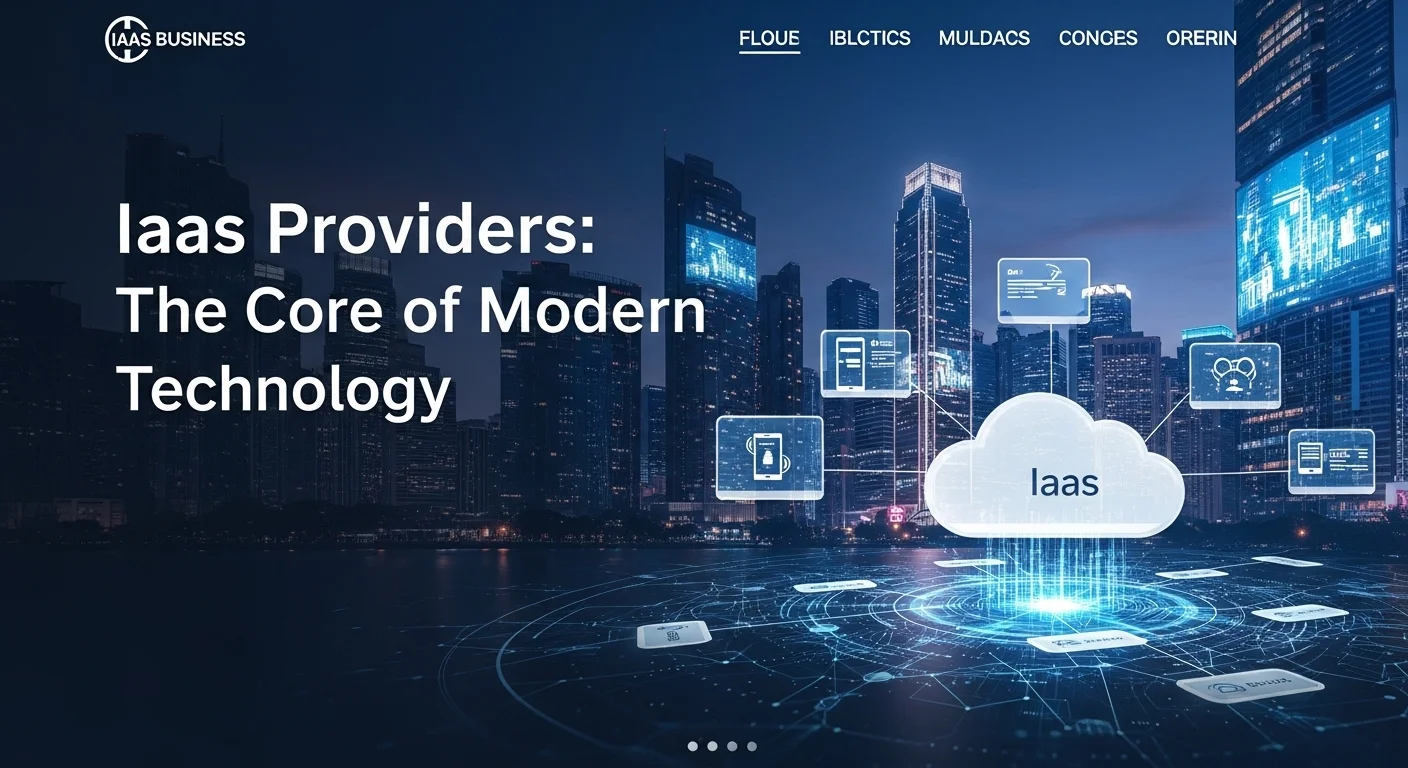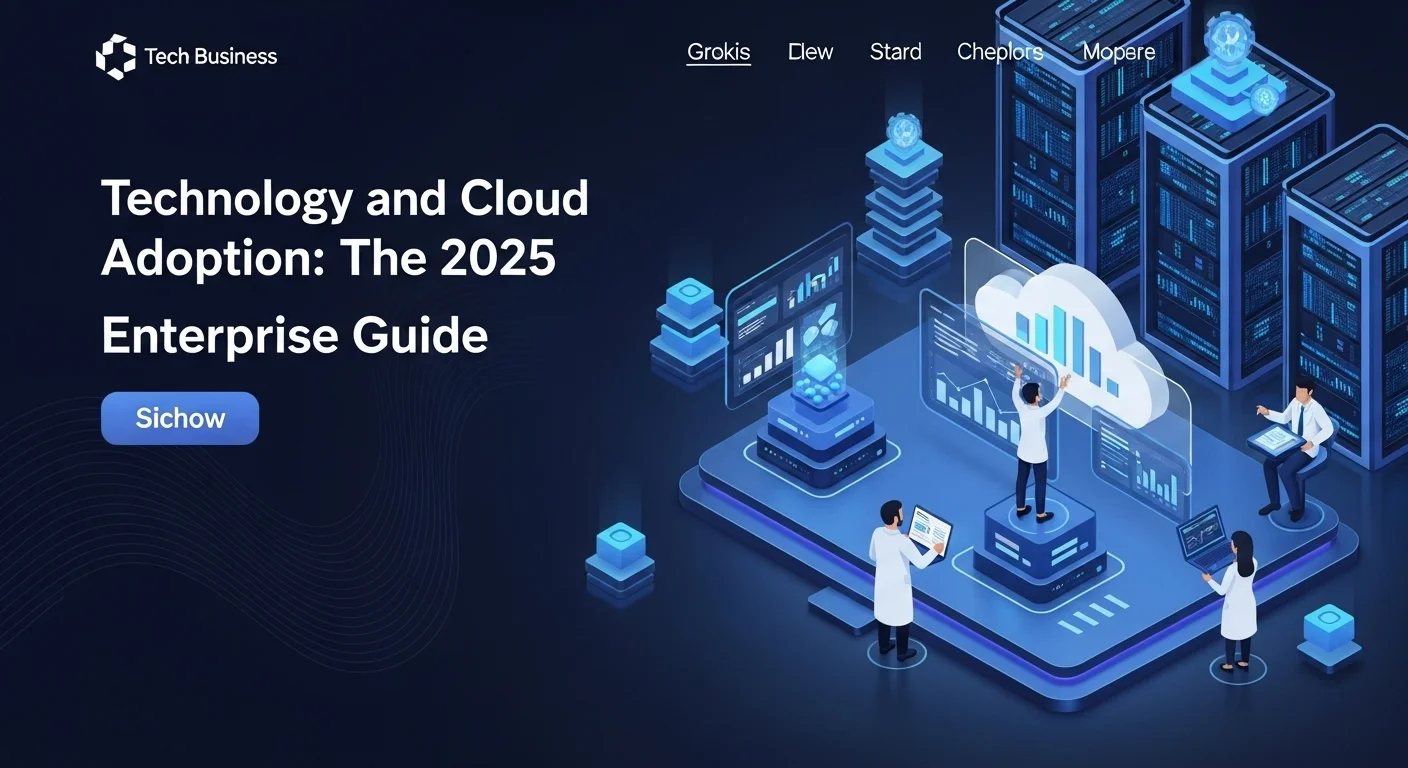Iaas Providers: The Core of Modern Technology

Executive Summary
Infrastructure as a Service (IaaS) represents a fundamental shift in how businesses access and manage their IT resources. Instead of investing in and maintaining physical hardware, companies can rent computing, storage, and networking components from IaaS providers on a pay-as-you-go basis. [1, 2] This model is the bedrock of modern cloud computing, offering unparalleled scalability, flexibility, and cost-efficiency. [2, 10] For technology leaders and business owners, understanding IaaS is crucial for driving digital transformation. It enables rapid deployment of applications, facilitates robust disaster recovery solutions, and powers demanding workloads like big data analytics and high-performance computing. [1, 5] By abstracting the physical infrastructure, IaaS allows teams to focus on innovation and core business objectives rather than hardware management. [17] This article explores the world of IaaS providers, from the dominant market leaders to niche players, providing a comprehensive guide to selecting the best solutions and implementing best practices. As technology evolves, the role of top IaaS providers will only become more critical in shaping the future of business operations and technological advancement.
Table of Contents
What is Iaas Providers and why is it important in Technology?
In the ever-evolving landscape of digital technology, businesses are constantly seeking more efficient, scalable, and cost-effective ways to manage their IT infrastructure. This quest has led to the widespread adoption of cloud computing, a paradigm with several service models. At the foundational level of cloud computing lies Infrastructure as a Service, commonly known as IaaS. Understanding what iaas providers offer is the first step toward harnessing the immense power of the cloud. IaaS is a cloud computing model where a third-party provider hosts and manages the core infrastructure components traditionally present in an on-premises data center, including servers (both physical and virtual), storage, and networking hardware. [7] These resources are delivered to consumers over the internet on demand, typically on a pay-as-you-go basis. [1] This model is analogous to renting land to build a house; the provider gives you the fundamental resources (the land and utilities), but you are responsible for building the house (your applications, data, and operating systems) on top of it. This gives organizations an incredible amount of flexibility and control without the substantial capital expenditure and maintenance overhead of owning physical hardware. [15]
The Core Components of IaaS
To fully grasp the concept, it's essential to break down the primary components that iaas cloud providers deliver. These are the building blocks that allow businesses to construct their virtual data centers. [15]
- Compute: This is the processing power that runs applications. IaaS providers offer virtual machines (VMs), which are software-based emulations of physical computers. [1] These VMs can be provisioned with specific amounts of CPU, RAM, and can run various operating systems. [26] For more intensive needs, some providers also offer bare-metal servers, which are dedicated physical servers without the virtualization layer, providing maximum performance and control. [1]
- Storage: Data needs a place to live, and IaaS offers various types of storage to suit different needs. Object storage is highly scalable and ideal for unstructured data like media files or backups. Block storage behaves like a traditional hard drive and is used for databases and applications requiring high performance. [2] File storage provides a shared file system accessible by multiple servers. The best iaas providers offer a tiered approach, allowing customers to choose cost-effective options for archival data versus high-performance options for active workloads. [11]
- Networking: IaaS includes virtualized networking resources that enable communication between compute and storage resources, and with the public internet. [1, 15] This is managed through software-defined networking (SDN), where components like routers, switches, and load balancers are available as services that can be configured via APIs. [1] This allows for the creation of isolated virtual private clouds (VPCs), complex network topologies, and robust security configurations.
The Technological Importance and Business Benefits of IaaS
The shift from on-premises infrastructure to IaaS is not just a change in location; it's a fundamental change in business and technology strategy with profound benefits. The importance of IaaS in modern technology cannot be overstated, as it underpins many of the digital services we use daily. For businesses, the advantages are transformative. One of the most significant benefits is cost savings. IaaS eliminates the need for large upfront capital expenditures (CapEx) on hardware and data center facilities. [2, 10] Instead, infrastructure costs become a predictable operational expense (OpEx), allowing businesses to pay only for the resources they consume. [17] This model democratizes access to enterprise-grade infrastructure, making it affordable for startups and small businesses. [17] Another key benefit is scalability and flexibility. With traditional infrastructure, scaling up to meet a sudden surge in demand (like for a retail website during a holiday sale) is slow and expensive. [17] With IaaS, resources can be scaled up or down automatically in minutes, ensuring performance is maintained without overprovisioning. [2] This elasticity is a game-changer for businesses with fluctuating workloads. [17] Furthermore, IaaS dramatically increases speed and agility. Development and testing teams can spin up new environments in minutes, rather than waiting weeks for hardware to be procured and configured. [1, 2] This accelerates innovation cycles and allows companies to bring new products and services to market much faster. [14] Reliability and disaster recovery are also vastly improved. Top IaaS providers operate global networks of data centers with built-in redundancy, ensuring high availability. [2] They offer sophisticated backup and disaster recovery solutions that are often more robust and cost-effective than what a single organization could build on its own. [1, 5] Finally, by outsourcing infrastructure management, IaaS allows IT teams to shift their focus from routine maintenance and troubleshooting to more strategic, value-added activities that directly support business goals. [17]
Business Applications and Use Cases
The versatility of IaaS makes it suitable for a wide range of applications across various industries. Many organizations begin their cloud journey by using IaaS for testing and development environments due to the speed and cost-effectiveness of creating and dismantling these setups. [1] Website and Web Application Hosting is another common use case, as IaaS provides the scalable infrastructure needed to handle variable traffic loads efficiently. [1, 5] For organizations dealing with massive datasets, IaaS is indispensable for big data analytics. It provides the immense processing power and scalable storage required to analyze large volumes of data to derive business insights, often leveraging integrated AI and machine learning services. [1, 2] Storage, backup, and recovery are critical functions that IaaS simplifies. Businesses can use the cloud for cost-effective, long-term data archival and for implementing robust disaster recovery plans, ensuring business continuity in the face of outages or cyberattacks. [5, 7] Moreover, IaaS is a key enabler of High-Performance Computing (HPC) for scientific research, financial modeling, and complex simulations, providing access to supercomputing capabilities on demand. [1] As businesses plan for the future, selecting from the top iaas providers 2025 will be a critical strategic decision, influencing their ability to innovate and compete. The continuous evolution of services from the best iaas providers ensures that the platform's capabilities will only grow, further cementing IaaS as a cornerstone of modern technology and business strategy. The adoption of a hybrid multicloud strategy, which combines on-premises infrastructure with services from multiple iaas cloud providers, is also becoming a standard approach, offering the ultimate flexibility and avoiding vendor lock-in. [1]

Complete guide to Iaas Providers in Technology and Business Solutions
Navigating the world of Infrastructure as a Service (IaaS) requires more than just understanding the concept; it demands a deep dive into the technical methods, business strategies, and the competitive landscape of the providers themselves. This guide is designed to equip technology leaders and businesses with the knowledge to make informed decisions when selecting and implementing solutions from the various iaas providers available. The right choice can accelerate innovation, while a mismatch can lead to unforeseen costs and complexities. [30] The foundation of IaaS is built on powerful technologies like virtualization. A hypervisor, or virtual machine monitor (VMM), is a software layer that allows multiple virtual machines, each with its own operating system and applications, to run on a single physical server. [1] This abstraction is what enables the efficient pooling and allocation of resources. Users interact with these resources not by physically touching hardware, but through APIs (Application Programming Interfaces) and web-based management consoles, which provide granular control over provisioning, configuring, and monitoring their virtual infrastructure. [5, 7] This programmability is a cornerstone of IaaS, enabling automation and integration with other systems.
A Comparative Analysis of the Top IaaS Providers
The IaaS market is dominated by a few major players, often referred to as the 'hyper-scalers', but also includes a vibrant ecosystem of niche providers catering to specific needs. A thorough comparison is essential for identifying the best iaas providers for your specific use case. Here, we'll explore the leaders and discuss what sets them apart.
1. Amazon Web Services (AWS)
Launched in 2006 with its Elastic Compute Cloud (EC2) and Simple Storage Service (S3), AWS is the pioneer and long-standing market leader in the IaaS space. [1, 4] Its market share is a testament to its maturity, reliability, and the sheer breadth and depth of its service portfolio. [4, 37]
Strengths: AWS boasts the most extensive and mature set of services, covering everything from basic compute and storage to advanced areas like quantum computing, IoT, and machine learning. [3, 37] Its global infrastructure is unparalleled, with numerous regions and availability zones ensuring low latency and high redundancy. [4] The AWS Marketplace is a vast ecosystem of third-party software and services that easily integrate with the platform. Its track record and extensive documentation make it a trusted choice for large enterprises running mission-critical workloads. [37]
Weaknesses: The sheer number of services can be overwhelming for new users, leading to a steep learning curve. While offering a free tier, its complex pricing structure can lead to unexpected costs if not managed carefully, a phenomenon often referred to as 'bill shock'. [36]
2. Microsoft Azure
As the second-largest player, Microsoft Azure has leveraged its strong foothold in the enterprise software market to become a formidable competitor. [4, 37]
Strengths: Azure's primary advantage is its seamless integration with other Microsoft products, such as Office 365, Dynamics 365, and Active Directory. This makes it an incredibly compelling choice for organizations already heavily invested in the Microsoft ecosystem. Azure excels in hybrid cloud solutions, with offerings like Azure Arc and Azure Stack that make it easier to manage resources across on-premises data centers and the public cloud. [4] It has strong enterprise support and is often seen as a strategic partner for digital transformation. [37]
Weaknesses: While its service portfolio is rapidly expanding, it is still slightly less comprehensive than AWS in some niche areas. Some users find its documentation and user interface less intuitive compared to its main competitor.
3. Google Cloud Platform (GCP)
Google Cloud Platform has established itself as a major contender, particularly known for its expertise in areas where Google itself excels. [4, 37]
Strengths: GCP is a leader in containers, Kubernetes (which originated at Google), big data, analytics, and machine learning. [4, 34] Its high-performance global network is another significant asset. GCP is often praised for its competitive and user-friendly pricing models, including per-second billing and sustained-use discounts that are applied automatically. [20] Its strengths make it one of the top iaas providers for cloud-native companies and those focused on data-driven innovation. [3]
Weaknesses: GCP's market share, while growing, is still third behind AWS and Azure, which means its ecosystem of third-party integrations and managed service providers is smaller. [4] It has historically been perceived as less enterprise-focused, although it has made significant strides to change this perception. [33]
Other Notable IaaS Cloud Providers
Beyond the 'big three', several other iaas cloud providers offer compelling solutions, often targeting specific segments of the market.
- Alibaba Cloud: The dominant cloud provider in China and the Asia-Pacific region, Alibaba Cloud offers a comprehensive portfolio of services comparable to the hyper-scalers. [3, 37] It is the go-to choice for businesses looking to operate in or expand to that part of the world. [3]
- Oracle Cloud Infrastructure (OCI): Oracle has leveraged its dominance in the database market to build a high-performance IaaS platform. OCI is particularly strong for running Oracle workloads and other high-performance, enterprise-grade applications. [4]
- IBM Cloud: With a focus on hybrid cloud and regulated industries like finance and healthcare, IBM Cloud offers a robust set of IaaS and PaaS services, often catering to large enterprises with complex compliance needs. [3, 4]
- Developer-Focused Providers (DigitalOcean, Linode, Vultr): These providers have carved out a niche by offering simple, affordable, and easy-to-use IaaS solutions. [3, 36] They appeal to individual developers, startups, and small businesses that don't need the vast complexity of the hyper-scalers but value straightforward pricing and excellent performance. [3, 33]
Business Techniques for Selecting the Right Provider
Choosing from the list of top iaas providers 2025 requires a strategic approach. It's not just about comparing features and prices. Businesses must consider several factors to ensure alignment with their long-term goals. [30]
- Assess Workload Requirements: Analyze the specific needs of your applications. Are they data-intensive, compute-intensive, or do they require specific compliance certifications? [21] A legacy enterprise application might be better suited for Azure or IBM Cloud, while a new cloud-native, data-analytics application might thrive on GCP.
- Evaluate Existing Expertise: Consider the skills of your IT team. If your team is proficient in Microsoft technologies, Azure might offer a smoother transition. [21]
- Consider Total Cost of Ownership (TCO): Look beyond the sticker price of VMs. Factor in costs for data transfer (egress fees), storage, support, and management tools. [13] A provider that seems cheaper initially might become more expensive as you scale.
- Review Security and Compliance: Security is paramount. Ensure the provider meets your industry's compliance standards (e.g., HIPAA for healthcare, PCI DSS for finance). [13, 30] Investigate their security measures, data encryption policies, and access control features. [39]
- Analyze the Ecosystem and Support: A strong ecosystem of partners, third-party tools, and a vibrant community can be invaluable. Evaluate the quality and responsiveness of the provider's technical support and the availability of professional services if needed. [13, 39]

Tips and strategies for Iaas Providers to improve your Technology experience
Adopting an Infrastructure as a Service (IaaS) model is the first major step in leveraging the power of the cloud. However, to truly maximize its benefits and achieve a superior technology experience, organizations must move beyond simple adoption and embrace strategic management and optimization. This involves implementing best practices across security, cost, performance, and automation. Without a proactive strategy, the flexibility of IaaS can lead to spiraling costs, security vulnerabilities, and inefficient operations. This section provides actionable tips and strategies for businesses to master their IaaS environment, ensuring it remains a powerful asset for innovation and growth. By focusing on these areas, you can ensure that your choice of iaas providers delivers the expected return on investment and drives your business forward. The insights here are crucial whether you are working with one of the best iaas providers or a more niche player, as the principles of good cloud governance are universal.
Mastering Security: The Shared Responsibility Model
One of the most critical concepts to understand in IaaS is the shared responsibility model. [7] The iaas cloud providers are responsible for the security *of* the cloud—protecting the physical data centers, servers, networking, and virtualization layer. However, you, the customer, are responsible for security *in* the cloud. [7, 9] This includes securing your data, applications, operating systems, and network configurations. Neglecting this responsibility is one of the biggest risks in cloud adoption.
Best Practices:
- Implement Strong Identity and Access Management (IAM): This is your first line of defense. Follow the principle of least privilege, granting users and services only the permissions they absolutely need to perform their tasks. [23] Use role-based access control (RBAC) and enforce multi-factor authentication (MFA) for all users, especially those with administrative access. [8, 23]
- Secure Your Network: Use virtual private clouds (VPCs) and subnets to isolate workloads. Configure network security groups and firewalls to control inbound and outbound traffic, only allowing necessary connections. [24]
- Encrypt Everything: While providers offer robust security, you should always encrypt sensitive data both in transit (using TLS) and at rest. [9, 23] Most top iaas providers offer key management services (like AWS KMS or Azure Key Vault) to help you control your encryption keys. [8]
- Continuously Patch and Harden: You are responsible for patching the operating systems and software running on your VMs. [9, 28] Automate this process to ensure you are protected against known vulnerabilities. [24] Use hardened, minimal OS images to reduce the potential attack surface.
Controlling Costs with Cloud Financial Management (FinOps)
The pay-as-you-go nature of IaaS is a huge benefit, but it can also be a double-edged sword. Without careful management, costs can quickly escalate. FinOps is an operational framework that brings financial accountability to the variable spend model of the cloud, enabling teams to make trade-offs between speed, cost, and quality. [35]
Strategies for Cost Optimization:
- Right-Size Your Resources: This is the most effective cost-saving measure. Continuously monitor the utilization of your VMs and storage. [27, 38] If a VM is consistently underutilized, resize it to a smaller, cheaper instance type. Most providers offer tools to help identify these opportunities. [11]
- Leverage Pricing Models: Don't just use on-demand pricing. For predictable, long-term workloads, use Reserved Instances (RIs) or Savings Plans, which offer significant discounts (up to 70%) in exchange for a 1- or 3-year commitment. [11, 35] For fault-tolerant, non-critical workloads like batch processing, use Spot Instances, which offer massive savings but can be interrupted with short notice. [11]
- Automate Shutdown of Idle Resources: Shut down development and testing environments outside of work hours. This simple automated script can cut costs for non-production workloads by more than 50%. [11, 27]
- Implement Tagging and Alerts: Enforce a strict tagging policy for all resources. This allows you to allocate costs to specific projects, departments, or teams, providing visibility and accountability. [11, 27] Set up billing alerts to notify you when spending exceeds predefined thresholds, preventing budget overruns. [43]
Enhancing Performance and Automation
To get the most out of your IaaS platform, you need to ensure your applications are performing optimally and that your infrastructure management is as efficient as possible. This is where monitoring, auto-scaling, and automation become critical.
Tips for Improvement:
- Monitor Performance Proactively: Use the native monitoring tools provided by your IaaS platform (e.g., Amazon CloudWatch, Azure Monitor) to track key metrics like CPU utilization, network traffic, and disk I/O. [9] Set up alarms to alert you to performance degradation before it impacts users.
- Use Auto-Scaling: For applications with variable traffic, configure auto-scaling groups. This will automatically add or remove VMs based on demand, ensuring you have enough capacity to handle peaks while saving money during quiet periods. [11]
- Embrace Infrastructure as Code (IaC): This is a transformative practice. Instead of manually configuring your infrastructure through a web console, define it in code using tools like Terraform, AWS CloudFormation, or Azure Resource Manager. [16, 18] This code is stored in a version control system (like Git), making your infrastructure repeatable, auditable, and easy to manage. [16] IaC reduces human error, accelerates deployments, and makes it simple to replicate environments for testing or disaster recovery. [18, 19] For more information on this, a great resource is the Red Hat guide to IaC.
Looking Ahead: The Future of IaaS and the top iaas providers 2025
The IaaS landscape is constantly evolving. As we look toward 2025, several trends are shaping the future of infrastructure technology. [6, 12] The top iaas providers 2025 will be those who lead in these areas:
- AI and ML Integration: AI will be further embedded into IaaS platforms, not just as a service to consume, but as a tool to manage the infrastructure itself, automating optimization and security tasks. [6, 40]
- Serverless Computing: While technically blurring the line with PaaS, serverless models (like AWS Lambda) are an evolution of IaaS, further abstracting the underlying servers and allowing developers to focus purely on code. [6, 12]
- Edge Computing: To reduce latency for applications like IoT and autonomous vehicles, providers are extending their infrastructure to the 'edge', closer to where data is generated and consumed. [12, 40]
- Sustainability: There will be an increasing focus on 'green computing', with providers investing in energy-efficient data centers and providing tools for customers to track and reduce the carbon footprint of their cloud workloads. [12]
Expert Reviews & Testimonials
Sarah Johnson, Business Owner ⭐⭐⭐
The information about Iaas Providers is correct but I think they could add more practical examples for business owners like us.
Mike Chen, IT Consultant ⭐⭐⭐⭐
Useful article about Iaas Providers. It helped me better understand the topic, although some concepts could be explained more simply.
Emma Davis, Tech Expert ⭐⭐⭐⭐⭐
Excellent article! Very comprehensive on Iaas Providers. It helped me a lot for my specialization and I understood everything perfectly.



